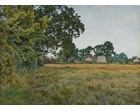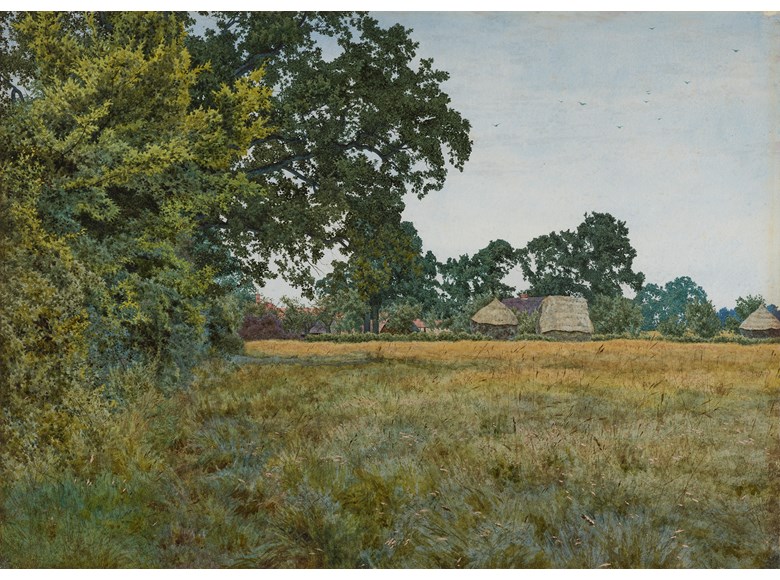 BACK TO GALLERY
BACK TO GALLERY
Lowell Libson & Jonny Yarker Ltd
William Fraser Garden
A Hayfield, Bedforshire
10 ¾ x 15 inches; 273 x 381 mm
description
This extraordinary, intensely worked watercolour is one of the most atmospheric landscapes by the late nineteenth-century British artist William Fraser Garden. Almost unknown in his own lifetime, Garden produced a sequence of watercolours which are startling for their haunting effect and technical virtuosity. Garden worked slowly and meticulously, producing a relatively small number of beautiful atmospheric watercolours which have long been highly prized by collectors. In the present work, showing the corner of a hayfield in high summer, Garden carefully records the scene with painstaking precision producing a vivid almost photographic treatment of the landscape. As Christopher Newall has observed, Garden’s ‘works of the late 1880s and 1890s are extraordinary in their pellucid quality of light and their exact delineation of architectural and landscape detail.’
Garden was born into a large family of artists of Scottish descent. His father Robert Winchester Fraser was an army surgeon, who settled in Bedford in 1861. In order to differentiate himself from his five artist brothers, Garden William Fraser used the name William Fraser Garden. Garden spent all his life painting the flat fen landscape of the Great Ouse, living in a series of houses between Bedford and Huntingdon, ending up bankrupt, lodging at the Ferry Boat Inn at Hemingford Grey. Garden had little professional success in his lifetime, he sent a series of watercolours to the Royal Academy during the 1880s but achieved no critical attention and little commercial success.
This exquisitely worked watercolour is one of the rare works he prepared for exhibition, it was shown at the Royal Academy in 1886. The still scene shows the corner of a hayfield bounded on one side by a coppice of trees and a range of agricultural buildings on the other. The buildings, glimpsed through hedge and more trees in full-leaf, include two distinctive conical hayricks with thatched tops. Garden has delighted in showing the rich foliage of the trees silhouetted against the summer light. The oblique framing of the composition and avoidance of conventional picturesque motifs suggests Garden was much influenced by photography. By the time Garden was painting, photography was widely available, and the potential of the medium was already decisively affecting the way landscape painters approached the world. Garden may even have known the pioneering photographer Peter Henry Emerson, whose naturalistic depictions of the same landscape were published in 1886 in an album entitled: Life and Landscape on the Norfolk Broads.
Garden was a master of watercolour technique, a perfectionist and an innovator. His landscapes, in their verisimilitude and precision, capture unerringly the feeling of a summer in the flat landscape of East Anglia. Using watercolour and carefully chosen paper, Garden portrays the effect of summer sun by extraordinary means. The foliage is created with rich areas of watercolour and gum Arabic, Garden’s meticulous delineation of each branch never lapses into derivativeness, preserving a fresh organic quality throughout. Garden’s work moved in a decisively different direction from the trajectory of British watercolour art, away from an aesthetic that privileged fleeting impressions made on the spot, towards a more solid vision, inflected by the rise of photography. Garden’s work revels in atmospheric effect, but it is effect that was hard won through laborious work in the studio.
Garden was born into a large family of artists of Scottish descent. His father Robert Winchester Fraser was an army surgeon, who settled in Bedford in 1861. In order to differentiate himself from his five artist brothers, Garden William Fraser used the name William Fraser Garden. Garden spent all his life painting the flat fen landscape of the Great Ouse, living in a series of houses between Bedford and Huntingdon, ending up bankrupt, lodging at the Ferry Boat Inn at Hemingford Grey. Garden had little professional success in his lifetime, he sent a series of watercolours to the Royal Academy during the 1880s but achieved no critical attention and little commercial success.
This exquisitely worked watercolour is one of the rare works he prepared for exhibition, it was shown at the Royal Academy in 1886. The still scene shows the corner of a hayfield bounded on one side by a coppice of trees and a range of agricultural buildings on the other. The buildings, glimpsed through hedge and more trees in full-leaf, include two distinctive conical hayricks with thatched tops. Garden has delighted in showing the rich foliage of the trees silhouetted against the summer light. The oblique framing of the composition and avoidance of conventional picturesque motifs suggests Garden was much influenced by photography. By the time Garden was painting, photography was widely available, and the potential of the medium was already decisively affecting the way landscape painters approached the world. Garden may even have known the pioneering photographer Peter Henry Emerson, whose naturalistic depictions of the same landscape were published in 1886 in an album entitled: Life and Landscape on the Norfolk Broads.
Garden was a master of watercolour technique, a perfectionist and an innovator. His landscapes, in their verisimilitude and precision, capture unerringly the feeling of a summer in the flat landscape of East Anglia. Using watercolour and carefully chosen paper, Garden portrays the effect of summer sun by extraordinary means. The foliage is created with rich areas of watercolour and gum Arabic, Garden’s meticulous delineation of each branch never lapses into derivativeness, preserving a fresh organic quality throughout. Garden’s work moved in a decisively different direction from the trajectory of British watercolour art, away from an aesthetic that privileged fleeting impressions made on the spot, towards a more solid vision, inflected by the rise of photography. Garden’s work revels in atmospheric effect, but it is effect that was hard won through laborious work in the studio.






 SEND AN EMAIL
SEND AN EMAIL